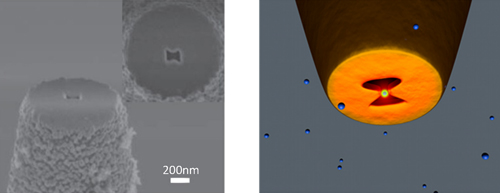Optical nano-tweezers allow for manipulating molecules, other nanoscale objects
March 7, 2014

The image on the left is an electron beam microscopy image of the extremity of the plasmon nano-tweezers. The image on the right is a sketch illustrating the trapping of a nanoparticle in the bowtie aperture. (Credit: Institute of Photonic Sciences)
Researchers at the Institute of Photonic Sciences (ICFO) in Catalonia have invented nano-optical tweezers capable of trapping and moving an individual nano-object in three dimensions using the force of light.
“This technique could revolutionize the field of nanoscience since, for the first time, we have shown that it is possible to trap, 3D-manipulate, and release a single nano-object without exerting any mechanical contact or other invasive action,” said Romain Quidant, ICREA Professor and leader at ICFO of the Plasmon Nano-Optics research group.
Invented in Bell Labs in the 80’s, optical trapping demonstrated the capability to trap and manipulate small objects of micrometer-size dimensions using laser light. By shining a laser light through a lens, it is possible to focus light in a tiny spot, creating an attractive force due to the gradient of the light intensity of the laser and thus attracting an object/specimen and maintaining it in the spot/focus.
However, optical tweezers have not been able directly trap objects smaller than a few hundreds of nanometers, such as proteins or nanoparticles, without overheating and damaging the specimen.
Plasmonic nano-tweezers
A few years ago, ICFO researchers demonstrated that, by focusing light on a very small gold nano-structure lying on a glass surface that acts as a nano-lens, one can trap a specimen at the vicinity of the metal where the light is concentrated. This proof of concept was limited to demonstrate the mechanism but did not enable any 3D manipulation needed for practical applications.
Now researchers at ICFO have taken this a crucial step further by implementing plasmonic nano-tweezers at the end of a mobile optical fiber that is nano-engineered with a bowtie-like gold aperture. Using this approach, they have demonstrated trapping and 3D displacement of specimens as small as a few tens of nanometers using extremely small, non-invasive laser intensity.
Both trapping and monitoring of the trapped specimen can be done through the optical fiber, performing the manipulation of nano-objects in a simple and manageable way outside of the physics research lab.
This technique opens up new research directions requiring non-invasive manipulation of objects at the single molecule/virus level, the researchers say. It is potentially attractive in the field of medicine as a tool to further understand the biological mechanisms behind the development of diseases. It also holds promise for assembling future miniaturized devices, among other potential applications.
“The next steps are to apply our nano tool to concrete problems,” Quidant told KurzweilAI. “We are willing to share our technology with anybody interested in using it for advancing his research. We hope this new technique becomes an universal tool for different kinds of scientists who would need to manipulate nano-objects in a non invasive way.”
This research was supported by the European Research Council through the grant Plasmolight no. 259196 and Fundació privada CELLEX.
Abstract of Nature Nanotechnology paper
Recent advances in nanotechnologies have prompted the need for tools to accurately and non-invasively manipulate individual nano-objects1. Among the possible strategies, optical forces have been predicted to provide researchers with nano-optical tweezers capable of trapping a specimen and moving it in three dimensions2, 3, 4. In practice, however, the combination of weak optical forces and photothermal issues has thus far prevented their experimental realization. Here, we demonstrate the first three-dimensional optical manipulation of single 50 nm dielectric objects with near-field nanotweezers. The nano-optical trap is built by engineering a bowtie plasmonic aperture at the extremity of a tapered metal-coated optical fibre. Both the trapping operation and monitoring are performed through the optical fibre, making these nanotweezers totally autonomous and free of bulky optical elements. The achieved trapping performances allow for the trapped specimen to be moved over tens of micrometres over a period of several minutes with very low in-trap intensities. This non-invasive approach is foreseen to open new horizons in nanosciences by offering an unprecedented level of control of nanosized objects, including heat-sensitive biospecimens.